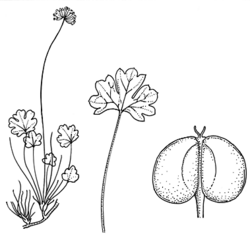Trachymene scapigera (Domin) B.L.Burtt APNI* Synonyms: Trachymene saniculifolia Stapf APNI*
Trachymene saniculaefolia orth. var. Stapf APNI*

Description: Perennial herb, to 10 cm high, rhizomatous.
Leaves in basal rosette; lamina 3–5-lobed to dissected, broad ovate in outline, 0.8–2 cm long, 1–3.5 cm wide; segments ovate to cuneate, 0.5–1.8 cm wide; covered by sparse long hairs; petiole 3–14 cm long.
Umbels 10–23 mm diam., 20–50 flowered on peduncles arising from the base, 12–35 cm long. Bracts 10–14, 2.5–7.5 mm long. Flowers bisexual or female. Petals 1.1–1.2 mm long, white. Ovary 2-locular.
Fruit broad ovate to orbicular, 3–5 mm long, brown; one or both mericarps maturing. Mericarps 2.5–3.6 mm wide, smooth. Carpophores entire, with four apical appendages, 0.6–0.8 mm long.
Flowering: Flowers December–March
Distribution and occurrence: Restricted to a few populations in eucalypt woodland adjacent to riparian Leptospermum thickets in Kanangra Boyd National Park west of Sydney.
NSW subdivisions: CT
Threatened species: NSW BCA: Endangered; Commonwealth EPBC: Endangered
Previously included in T. saniculifolia Stapf, which occurs on the Philippine Islands, Borneo and New Guinea, but differs in bearing leafy stems arising from the basal rosettes. Formerly in Apiaceae.
Text by J.M. Hart
Taxon concept: J.M. Hart, 2002
APNI* Provides a link to the Australian Plant Name Index (hosted by the Australian National Botanic Gardens) for comprehensive bibliographic data
***The AVH map option provides a detailed interactive Australia wide distribution map drawn from collections held by all major Australian herbaria participating in the Australian Virtual Herbarium project.
|


